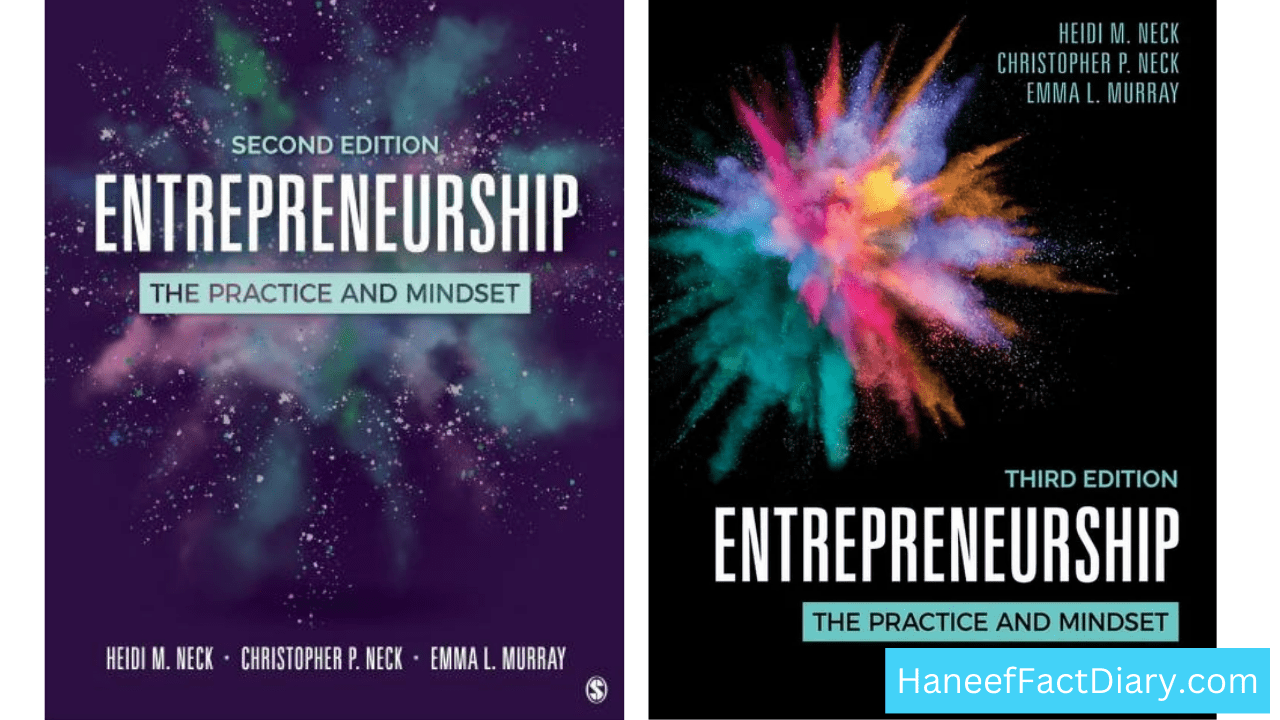Entrepreneurship The Practice and Mindset 2nd,3rd EDITION Free
Entrepreneurship The practice and the mindset SECOND EDITION and THIRD EDITION take students outside of the classroom, by helping to create an entrepreneurial mindset, so they can make opportunities and act in a variety of uncertain situations. You can find the pdf in the bottom section of this article. you could also suggest your thoughts or requests in the comment section below and if you need any more resources in the current book, do share your requirements too
Authors
- Heidi M. Neck – Babson College, USA
- Christopher P. Neck – Arizona State University, USA
- Emma L. Murray
DESCRIPTION
The recipient of a 2021 Textbook Excellence Award from the Textbook & Academic Authors Association (TAA)
Entrepreneurship The practice and the mindset take students outside of the classroom, by helping to create an entrepreneurial mindset, so they can make opportunities and act in a variety of uncertain situations.
For a better understanding of the mindset go through this masterpiece on Entrepreneur’s Mindset: Key to Success Unlocking
Based on the renowned Babson Entrepreneurship curriculum it focuses on the practice of learning and learning through action. Students are taught entrepreneurship by taking small steps to gain feedback, test, and develop ideas.
They will leave this book with an entrepreneurial mindset, knowledge, and tools that can be used in companies and startups of all types. If your students are educated in liberal arts, business engineering, and sciences, this book will guide them through a transformative journey that will teach them essential life abilities.
This second edition includes an updated chapter on developing customers and 15 case studies, 16 brand-new Mindshift activities, and 16 new Entrepreneurship In Action Profiles, and a broader coverage of incubators, prototyping accelerators, team building, and the latest trends in marketing.
CONTENTS
Preface
Acknowledgments
About the Authors
Part I. Entrepreneurship Is a Life Skill
CHAPTER 1: Practicing Entrepreneurship
- 1.1 Entrepreneurship Requires Action and Practice
- 1.2 Entrepreneurship May Be Different From What You Think
- 1.3 Types of Entrepreneurship
- 1.4 Entrepreneurship Is a Method, Not a Process
- 1.5 The Method Involves Creating the Future, Not Predicting It
- 1.6 The Key Components of the Entrepreneurship Method
- 1.7 Entrepreneurship Requires Deliberate Practice
- 1.8 How This Book Will Help You Practice Entrepreneurship
Summary
- Key Terms
- Case Study: Saurabh Gupta, founder, Gyan-I Inc.
CHAPTER 2: Activating an Entrepreneurial Mindset
- 2.1 The Power of Mindset
- 2.2 What Is Mindset?
- 2.3 The Self-Leadership Habit
- 2.4 The Creativity Habit
- 2.5 The Improvisation Habit
- 2.6 The Mindset as the Pathway to Action
Summary
- Key Terms
- Case Study: Maliha Khalid, founder and CEO, Doctory
Part II. Creating and Developing Opportunities
CHAPTER 3: Creating and Recognizing New Opportunities
- 3.1 The Entrepreneurial Mindset and Opportunity Recognition
- 3.2 Opportunities Start With Thousands of Ideas
- 3.3 Four Pathways to Opportunity Identification
- 3.4 Alertness, Prior Knowledge, and Pattern Recognition
- 3.5 From Idea Generation to Opportunity Recognition
Summary
- Key Terms
- Case Study: Jillian Lakritz, founder, Yoee Baby
CHAPTER 4: Using Design Thinking
- 4.1 What Is Design Thinking?
- 4.2 Design Thinking as a Human-Centered Process
- 4.3 Design Thinking Requires Empathy
- 4.4 The Design-Thinking Process: Inspiration, Ideation, Implementation
- 4.5 Pathways Toward Observation and Insights
- 4.6 Interviewing as a Useful Technique for Identifying Needs
- 4.7 Variations of the Design-Thinking Process
Summary
- Key Terms
- A Case Study Anton Yakushin, cofounder and CEO of VentureBlocks
CHAPTER 5: Building Business Models
- 5.1 What Is a Business Model?
- 5.2 The Four Parts of a Business Model
- 5.3 The Customer Value Proposition (CVP)
- 5.4 Different Types of CVPs and Customer Segments
- 5.5 The Business Model Canvas (BMC)
Summary
- Key Terms
- A Case Study Gautam Gupta who co-founded NatureBox
CHAPTER 6: Developing Your Customers
- 6.1 Customers and Markets
- 6.2 Types of Customers
- 6.3 Customer Segmentation
- 6.4 Target Customer Group
- 6.5 Customer Personas
- 6.6 Customer Journey Mapping Process
- 6.7 Market Sizing
Summary
- Key Terms
- Case Study: Haim Saban, The Mighty Morphin’ Power Rangers
CHAPTER 7: Testing and Experimenting With New Ideas
- 7.1 Experiments: What They Are and Why We Do Them
- 7.2 Types of Experiments
- 7.3 A Deeper Look at Prototypes
- 7.4 Hypothesis Testing and the Scientific Method Applied to Entrepreneurship
- 7.5 The Experimentation Template
- 7.6 Interviewing for Customer Feedback
Summary
- Key Terms
- Case Study: Katrina Lake, CEO, Stitch Fix
CHAPTER 8: Developing Networks and Building Teams
- 8.1 The Power of Networks
- 8.2 The Value of Networks
- 8.3 Building Networks
- 8.4 Virtual Networking
- 8.5 Networking to Build the Founding Team
Summary
- Key Terms
- Case Study: Jeff Goudie, American Packaging
Part III. Evaluating and Acting on Opportunities
CHAPTER 9: Creating Revenue Models
- 9.1 What Is a Revenue Model?
- 9.2 Different Types of Revenue Models
- 9.3 Generating Revenue From “Free”
- 9.4 Revenue and Cost Drivers
- 9.5 Pricing Strategies
- 9.6 Calculating Price
Summary
- Key Terms
- A Case Study Balaji Viswanathan, founder, Invento Robotics
CHAPTER 10: Planning for Entrepreneurs
- 10.1 What Is Planning?
- 10.2 Planning Starts With a Vision
- 10.3 Plans Take Many Forms
- 10.4 Questions to Ask During Planning
- 10.5 The Business Plan Debate
- 10.6 Tips for Writing Any Type of Plan
Summary
- Key Terms
- Case Study: Boyd Cohen, cofounder, IoMob
CHAPTER 11: Anticipating Failure
- 11.1 Failure and Entrepreneurship
- 11.2 The Failure Spectrum
- 11.3 Fear of Failure
- 11.4 Learning From Failure
- 11.5 Getting Gritty: Building a Tolerance for Failure
Summary
- Key Terms
- A Case Study Emily Lagasse, founder, Petwell Supply Co.
Part IV. Supporting New Opportunities
CHAPTER 12: Bootstrapping and Crowdfunding for Resources
- 12.1 What Is Bootstrapping?
- 12.2 Bootstrapping Strategies
- 12.3 Crowdfunding Versus Crowdsourcing
- 12.4 Crowdfunding Startups and Entrepreneurship
- 12.5 The Four Contexts for Crowdfunding
- 12.6 A Quick Guide to Successful Crowdfunding
Summary
- Key Terms
- A Case Study Daymond John, founder, FUBU
CHAPTER 13: Financing for Startups
- 13.1 What Is Equity Financing?
- 13.2 The Basics of Valuation
- 13.3 Angel Investors
- 13.4 Venture Capitalists
- 13.5 Due Diligence
Summary
- Key Terms
- A Case Study of Rich Palmer, founder, Gravyty
SUPPLEMENT A: Financial Statements and Projections for Startups
- Financial Projections for Startups
- Three Essential Financial Statements
- Linkages Between the Three Financial Statements
- The Journey of Cash: The Cash Conversion Cycle
- Building Pro Forma Financial Statements
- Building Assumptions: Operating Policies and Other Key Assumptions
Summary
- Key Terms
CHAPTER 14: Navigating Legal and IP Issues
- 14.1 Legal Considerations
- 14.2 Types of Legal Structures
- 14.3 Legal Mistakes Made by Startups
- 14.4 Intellectual Property (IP)
- 14.5 Global IP Theft
- 14.6 Common IP Traps
- 14.7 Hiring Employees
Summary
- Key Terms
- The Case Study is Matthew Vega Sanz, cofounder of Lula
CHAPTER 15: Engaging Customers Through Marketing
- 15.1 What Is Entrepreneurial Marketing?
- 15.2 The Basic Principles of Marketing
- 15.3 Building a Brand
- 15.4 Entrepreneurial Marketing
- 15.5 Creating Your Personal Brand
Summary
- Key Terms
- A Case Study Justin Real, founder, Realplay
SUPPLEMENT B: The Pitch Deck
- Types of Pitches
- Overview of the Pitch Deck
- The Pitch Deck
- The Question and Answer Period
- Public Speaking Tips
Summary
- Key Term
CHAPTER 16: Supporting Social Entrepreneurship
- 16.1 The Role of Social Entrepreneurship
- 16.2 Social Entrepreneurship and Wicked Problems
- 16.3 Types of Social Entrepreneurship
- 16.4 Capital Markets for Social Entrepreneurs
- 16.5 Social Entrepreneurs and Their Stakeholders
- 16.6 Differences Between Social Entrepreneurship and Corporate Social Responsibility
- 16.7 Social Entrepreneurship and Audacious Ideas
- 16.8 Global Entrepreneurship
Summary
- Key Terms
- A Case Study Brandale Randolph, founder and CEO of the 1854 Cycling Company
Glossary
Notes
Name Index
Subject Index
Entrepreneurship The practice and the mindset Features
NEW TO THIS EDITION:
- The latest edition is now available as a digital download via SAGE Vantage the intelligent digital platform that features automated graded assignments as well as interactive multimedia tools that include video, all designed to help students better prepare for classes. Learn more.
- The new section on developing your customers assists students in gaining an understanding of the needs of customers.
- 15 brand new case studies and 16 brand new Entrepreneurship In Actionprofiles showcase a variety of entrepreneurs and start-ups.
- 16 brand new Mindshift Activities offer students more opportunities to build their entrepreneurial skills and mindset.
- A new and expanded scope of prototyping accelerators, incubators, and creating teams, as well as marketing developments.
- Table of Contents that are streamlined allows students to start exploring possibilities prior to reading the entire text.
- Recent research with statistics, examples, and research throughout.
KEY FEATURES:
- 2 Mindshifting Activities for each chapter require students to get involved outside the classroom and engage in entrepreneurial activities.
- Instructors are given specific, innovative experiential learning exercises.
- The chapter about Learning From Failure helps students anticipate setbacks, build confidence, and appreciate the importance of experiments and repetition.
- A comprehensive overview of current subjects like design thinking Canvas for business models, crowdfunding, and bootstrapping are discussed in depth teaching your students about the most current advancements within the industry.
- The book ends with the creation of your pitch Deck providing an example to help students design an unforgettable and unique method of presenting their business plan to investors.
- VentureBlocks Simulation is available in conjunction with the book to help students develop entrepreneurial skills. It was created by Heidi Neck and Anton Yakushin the simulation requires students to take on missions where they test their interviewing skills, identify new opportunities, and then review what they learned.
- Assignmentable SAGE Premium Videos ( available via the SAGE Vantage platform, and linked to SAGE Coursepacks) that are linked to learning goals, and are curated and created exclusively in this book to help bring concepts to life and include Entrepreneur Challenge, Entrepreneurship in Action, and the Making the Pitch videos. They include assessment questions that can be assigned as well as complete assignable chapter knowledge check tests as well as a thorough chapter test that brings the content to life in a way that an ordinary print book can’t.







